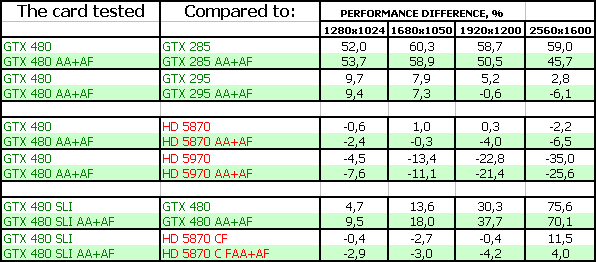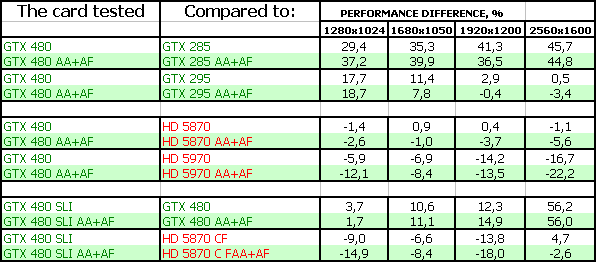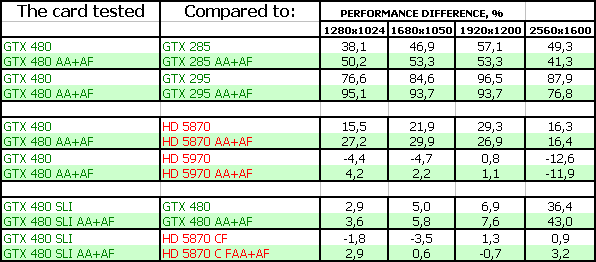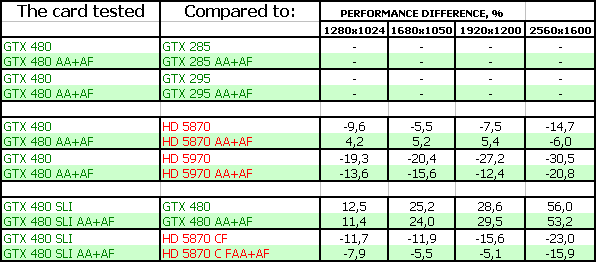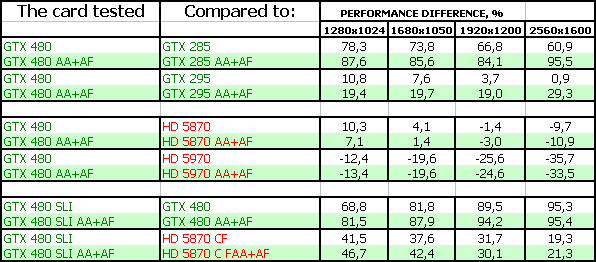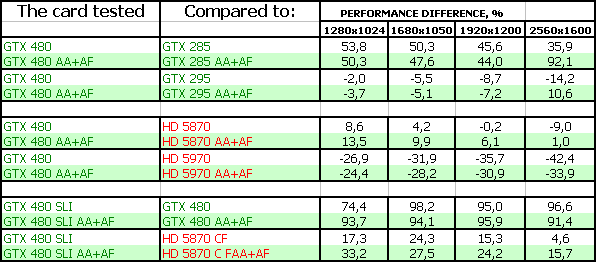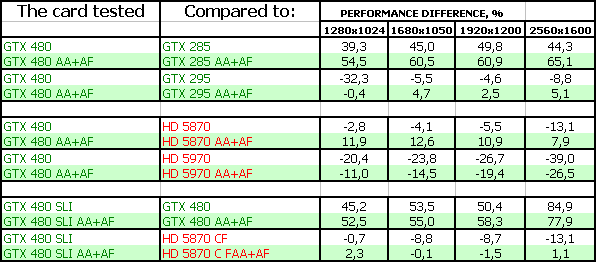NVIDIA GeForce GTX 480 Graphics Card
|
Performance in games
Testbed:
- Intel Core i7-920 CPU (2667 MHz);
- ASUS P6T Deluxe motherboard with the Intel X58 chipset;
- 3GB DDR3 SDRAM Corsair 1066MHz;
- WD Caviar SE WD1600JD 160GB SATA hard drive;
- Tagan TG900-BZ 900W PSU;
- Windows Vista 32-bit SP1, DirectX 11;
- Dell 3007WFP 30-inch monitor;
- ATI Catalyst 10.3; NVIDIA 197.17 drivers;
- VSync disabled.
Benchmarks:
- Far Cry 2 (Ubisoft) -- DirectX 10.0, shaders 4.0 (HDR), built-in benchmarking utility (the Middle level), maximum settings.
- CRYSIS 1.2 (Crytek/EA) -- Rescue, DirectX 10.0, shaders 4.0, Very High settings, batch file, timedemo available by e-mail request.
- CRYSIS Warhead (Crytek/EA) -- Cargo, DirectX 10.0, shaders 4.0, Very High settings, batch file, timedemo available by e-mail request.
- Colin McRae: DiRT 2 (Codemasters) -- DirectX 10.0/11.0, Ultra High settings, run the benchmark as follows: "dirt2.exe -benchmark example_benchmark.xml".
- Warhammer 40.000: Dawn Of War II (Relic Entertainment/THQ) -- DirectX 9.0, Super High settings, run the benchmark from the in-game menu.
- Just Cause 2 (Avalanche Studios/Eidos Interactive) -- DirectX 11.0, Super High settings, run the benchmark from the in-game menu.
- Tropics Benchmark 1.2 (Unigine) -- DirectX 10.0, High settings.
- Heaven Benchmark 1.1 (Unigine) -- DirectX 10.0, High settings.
- Heaven Benchmark 1.1 (Unigine) -- DirectX 11.0, High settings.
- 3DMark Vantage 1.02 (FutureMark) -- DirectX 10.0, shaders 4.0, multitexturing, Extreme settings.
We'd like to thank Unigine for helping us set up their benchmarks.
Note that a newer Heaven Benchmark 2.0 was released when we were making this review. So, our next article will feature the updated version.
Far Cry 2
Crysis, Rescue
Crysis Warhead, Cargo
Colin McRae: DiRT 2
Warhammer 40.000: Dawn Of War II
Just Cause 2
Unigine Tropics Benchmark
Unigine Heaven Benchmark DirectX 10.0
Unigine Heaven Benchmark DirectX 11.0
3DMark Vantage Graphics Marks
Conclusions
Before drawing any conclusions we'll dot the i's on what has already gained momentum on the Web.
As you may know, NVIDIA accused AMD of reducing image quality in Warhammer 40.000: Dawn Of War II by means of Catalyst AI for the sake of higher performance. So NVIDIA recommends that testers disable it to compare performance at the same quality. According to our tests, enabling Catalyst AI from ATI Catalyst 10.3 resulted in very small changes in performance. However, earlier versions of ATI Catalyst produced a more noticeable difference. Therefore, to keep our experiments pure, we ran Warhammer 40.000: Dawn Of War II with Catalyst AI disabled. Besides, it actually reduced image quality. However, this is a DX9 game, so it's not very interesting in terms of future innovations anyway. After all, if you buy a DirectX 11 graphics card, you'll want to play corresponding games, won't you?
As a retort, AMD claimed that NVIDIA's GTX 4xx series used DX9 instead of DX11 in the Colin McRae: DiRT 2 demo -- also to boost performance. We can confirm that the full version of Colin McRae: DiRT 2 we use in our tests has GeForce GTX 480 working in the DX11 mode. We checked this a few times, just to be sure. So this benchmark remains objective, because all of the competitors work in the DX11 mode.
All right, enough nonsense, let's proceed to conclusions.
NVIDIA GeForce GTX480 1536MB is a very interesting solution from the angle of the DirectX 11 API. It demonstrates excellent tesselation potential and is obviously ready for future games. As you remember, GeForce GTX 480 won two of the three DX11 tests. However, it doesn't go without drawbacks, e.g. noise. This can disappoint many a user. Of course, enthusiasts won't care much about noise, but still it's a drawback. On the other hand, the new graphics card has the standard length, 270mm, while Radeon HD 5870 is longer. This is a nice advantage, because HD 5870 just doesn't fit in some decently sized PC enclosures.
Anyway, in general, GeForce GTX 480 performs just a bit better than Radeon HD 5870. At high resolutions its performance is bottlenecked by memory bandwidth. It's somewhat strange that NVIDIA uses 40x memory chips in this graphics card (and even declocks them), when there are 50x ones available in the market. Actually, this may be done to fit the graphics card in the 300W power consumption envelope. Reducing the number of stream processors from 512 to 480 is probably done for the same reason. That and to increase the yield of ready GPUs. Does it mean there will be GeForce GTX 490 with 512 stream processors?
Speaking of pricing, the MSRP of $499 is obviously overstated and needs to be corrected by the market and demand.
Let's say a few words about secondary features. NVIDIA GeForce GTX 480 has excellent support for the latest physical computing innovations. This may also become a benefit. And don't forget about SLI. A couple of such graphics cards will provide much gaming potential for months to come. Besides, you will also be able to output video signal to three monitors simultaneously, even in the stereo mode (stay tuned for a review dedicated to NVIDIA 3D Vision and ATI Eyefinity). Or you'll be able to turn SLI off and use the second card solely for physical effects. Of course, such a configuration will be very noisy, hot, and power-hungry. You'll need at least a 1000W PSU. Speaking of heat, perhaps, NVIDIA partners will roll out their customized solutions with improved coolers.
It's rather hard to draw a straightforward conclusion this time. GeForce GTX 480 has both potential and drawbacks. However, the more tesselation-enabled games are released the more victorious it will be. For this reason, we should probably wait a year, maybe less, and see. The situation may change noticeably.
Anyway, today, GeForce GTX 480 can be considered the fastest single-GPU graphics card of excellent potential. Radeon HD 5970 remains the absolute gaming leader at that, but it's is more expensive and much larger. Also have in mind that dual-GPU solutions are always more sensitive and vulnerable to drivers quality.
The PSU is provided by TAGAN, the monitor is provided by NVIDIA.
Write a comment below. No registration needed!
|
|
 |
Article navigation:
Page 1: Introduction, specs, key features
Page 2: GPC, SM, Scheduler, TMUs
Page 3: PolyMorph and Raster Engines, memory, ROPs
Page 4: General-purpose computing, ray tracing, etc.
Page 5: Design, cooling
Page 6: DX9 synthetic tests
Page 7: DX10 synthetic tests
Page 8: More DX10 synthetic tests
Page 9: 3DMark Vantage Feature Tests
Page 10: DX11 synthetic tests
Page 11: More DX11 synthetic tests
Page 12: Performance in games, conclusions
|
|
|


